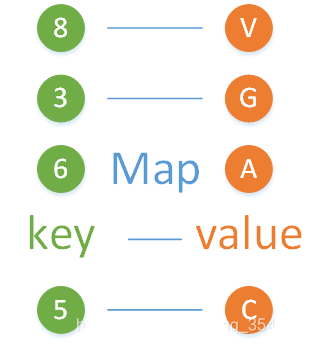資料結構實現 5.2:對映_基於連結串列實現(C++版)
阿新 • • 發佈:2018-11-27
資料結構實現 5.2:對映_基於連結串列實現(C++版)
1. 概念及基本框架
.
在 5.1 中我們通過 二分搜尋樹 來實現了對映,這一節我們通過 連結串列 來實現對映。

對映 的基本特性依然要滿足:
1.對映內元素包含 鍵(key) 和 值(value) ,而且一一對應。
2.對映內的元素的鍵 不能重複 。
注:有些對映(多重對映)中元素的鍵也可以重複。
在 2.1 中實現的連結串列結點只有一個數據,所以我們需要從底層進行一些改進去適應對映這一資料結構。首先來定義連結串列的結點類:
template <class K, class V>
class MapNode{
public:
MapNode(K key = NULL, V value = NULL, MapNode<K, V> *next = NULL){
m_key = 這個結點類的內部也顯式的給出了建構函式,下面通過結點類來建立一個對映類。
注:這裡我們也可以先實現一個連結串列類,然後通過連結串列來實現對映類。
有了改進版的連結串列結點,我們就可以利用一個由 純虛擬函式 構成的 抽象類 作為一個介面來定義這些操作。具體程式碼如下:
template <class K, class V>
class Map{
public: 下面只需要通過繼承 抽象類,並且重寫 純虛擬函式 ,就可以完成 對映 的實現。對映類的框架如下:
template <class K, class V>
class LinkedListMap : public Map<K, V>{
public:
LinkedListMap(){
head.m_key = NULL;
head.m_value = NULL;
head.next = NULL;
m_size = 0;
}
...
private:
MapNode<K, V> head;
int m_size;
};
這裡為了避免重複設計就可以相容更多資料型別,引入了 泛型 ,即 模板 的概念。(模板的關鍵字是 class 或 typename)
這裡連結串列加了虛擬頭結點,同樣,為了保護資料,變數設定為 private 。
實現了前面的程式之後,接下來就是一個對映的增、刪、改、查以及一些其他基本操作,接下來利用程式碼去實現。
2. 基本操作程式實現
2.1 增加操作
template <class K, class V>
class LinkedListMap : public Map<K, V>{
public:
...
//增加操作
void add(K key, V value){
if (!contains(key)){
MapNode<K, V> *p = new MapNode<K, V>(key, value, head.next);
head.next = p;
m_size++;
}
}
...
};
需要查詢連結串列是不是已經包含該鍵。
2.2 刪除操作
template <class K, class V>
class LinkedListMap : public Map<K, V>{
public:
...
//刪除操作
V remove(K key){
MapNode<K, V> *pre = &head;
MapNode<K, V> *node = pre->next;
while (node){
if (key == node->m_key){
pre->next = node->next;
V res = node->m_value;
delete node;
m_size--;
return res;
}
pre = node;
node = node->next;
}
cout << "對映中不包含" << key << '!' << endl;
return NULL;
}
...
};
2.3 修改操作
template <class K, class V>
class LinkedListMap : public Map<K, V>{
public:
...
//修改操作
void set(K key, V value){
MapNode<K, V> *node = head.next;
while (node){
if (key == node->m_key){
node->m_value = value;
return;
}
node = node->next;
}
cout << "對映中不包含" << key << '!' << endl;
}
...
};
2.4 查詢操作
template <class K, class V>
class LinkedListMap : public Map<K, V>{
public:
...
//查詢操作
bool contains(K key){
MapNode<K, V> *node = head.next;
while (node){
if (key == node->m_key){
return true;
}
node = node->next;
}
return false;
}
V get(K key){
MapNode<K, V> *node = head.next;
while (node){
if (key == node->m_key){
return node->m_value;
}
node = node->next;
}
cout << "對映中不包含" << key << '!' << endl;
return NULL;
}
...
};
2.5 其他操作
對映還有一些其他的操作,包括 對映大小 的查詢等操作。
template <class K, class V>
class LinkedListMap : public Map<K, V>{
public:
...
int size(){
return m_size;
}
bool isEmpty(){
return m_size == 0;
}
...
};
3. 演算法複雜度分析
3.1 增加操作
| 函式 | 最壞複雜度 | 平均複雜度 |
|---|---|---|
| add | O(n) | O(n/2) = O(n) |
因為需要判斷是否存在該元素,所以需要遍歷一遍整個連結串列。
3.2 刪除操作
| 函式 | 最壞複雜度 | 平均複雜度 |
|---|---|---|
| remove | O(n) | O(n/2) = O(n) |
3.3 修改操作
| 函式 | 最壞複雜度 | 平均複雜度 |
|---|---|---|
| set | O(n) | O(n/2) = O(n) |
3.4 查詢操作
| 函式 | 最壞複雜度 | 平均複雜度 |
|---|---|---|
| contains | O(n) | O(n/2) = O(n) |
| get | O(n) | O(n/2) = O(n) |
總體情況:
| 操作 | 時間複雜度 |
|---|---|
| 增 | O(n) |
| 刪 | O(n) |
| 改 | O(n) |
| 查 | O(n) |
與利用二分搜尋樹實現的對映相比,利用連結串列實現的對映操作的時間複雜度就增大了很多。
4. 完整程式碼
程式完整程式碼(這裡使用了標頭檔案的形式來實現類)如下。
抽象類 介面程式碼:
#ifndef __MAP_H__
#define __MAP_H__
template <class K, class V>
class Map{
public:
virtual int size() = 0;
virtual bool isEmpty() = 0;
//增加操作
virtual void add(K key, V value) = 0;
//刪除操作
virtual V remove(K key) = 0;
//修改操作
virtual void set(K key, V value) = 0;
//查詢操作
virtual bool contains(K key) = 0;
virtual V get(K key) = 0;
};
#endif
對映類 程式碼:
#ifndef __LINKEDLISTMAP_H__
#define __LINKEDLISTMAP_H__
#include "Map.h"
template <class K, class V>
class MapNode{
public:
MapNode(K key = NULL, V value = NULL, MapNode<K, V> *next = NULL){
m_key = key;
m_value = value;
this->next = next;
}
public:
K m_key;
V m_value;
MapNode<K, V> *next;
};
template <class K, class V>
class LinkedListMap : public Map<K, V>{
public:
LinkedListMap(){
head.m_key = NULL;
head.m_value = NULL;
head.next = NULL;
m_size = 0;
}
int size(){
return m_size;
}
bool isEmpty(){
return m_size == 0;
}
//增加操作
void add(K key, V value){
if (!contains(key)){
MapNode<K, V> *p = new MapNode<K, V>(key, value, head.next);
head.next = p;
m_size++;
}
}
//刪除操作
V remove(K key){
MapNode<K, V> *pre = &head;
MapNode<K, V> *node = pre->next;
while (node){
if (key == node->m_key){
pre->next = node->next;
V res = node->m_value;
delete node;
m_size--;
return res;
}
pre = node;
node = node->next;
}
cout << "對映中不包含" << key << '!' << endl;
return NULL;
}
//修改操作
void set(K key, V value){
MapNode<K, V> *node = head.next;
while (node){
if (key == node->m_key){
node->m_value = value;
return;
}
node = node->next;
}
cout << "對映中不包含" << key << '!' << endl;
}
//查詢操作
bool contains(K key){
MapNode<K, V> *node = head.next;
while (node){
if (key == node->m_key){
return true;
}
node = node->next;
}
return false;
}
V get(K key){
MapNode<K, V> *node = head.next;
while (node){
if (key == node->m_key){
return node->m_value;
}
node = node->next;
}
cout << "對映中不包含" << key << '!' << endl;
return NULL;
}
private:
MapNode<K, V> head;
int m_size;
};
#endif
